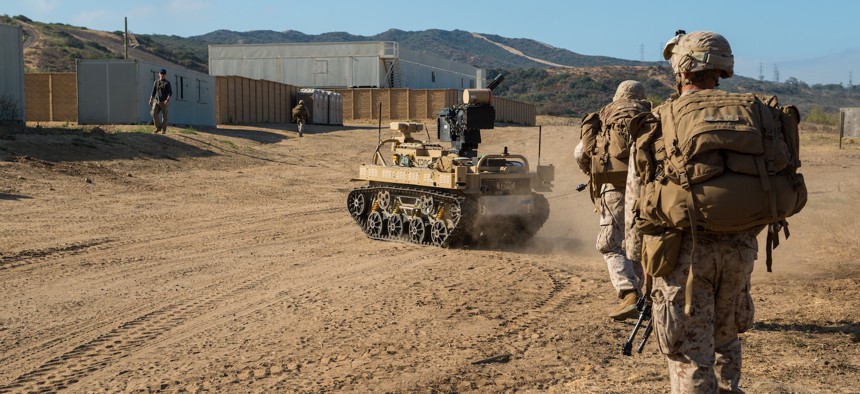
Marines with 3rd Battalion, 5th Marine Regiment conduct a patrol with a Weaponized Multi-Utility Tactical Transport vehicle at Marine Corps Base Camp Pendleton, Calif., July 13, 2016. Lance Cpl. Julien Rodarte / 15th Marine Expeditionary Unit
The US Navy Is Testing 5G For Future Forward Operating Bases
From drone-deployed 5G networks to digital twinning, a small 5G pilot is rewriting the rules for battlefield connectivity.
The Navy’s SoCal Tech Bridge at Marine Corps Air Station Miramar is experimenting with new 5G networks carried on the back of autonomous vehicles, so that when future robo-amphibs storm the beach, they can bring their own 5G network with them.
The program, called eTHOR, looks to “generate a private 5G network that supports forward operating bases,” via an electric autonomous vehicle, Marine Capt. Benjamin Cohen, director of the NavalX Southern California TechBridge, said during a Defense One event this week.
Future forward operating bases in dangerous spots will need a lot of connectivity to help human operators use drones, sense intruders, and coordinate with jets, ships, or other forces faster than the enemy. And they’ll need that connectivity in an environment where the adversary owns the phone lines and is likely using advanced electromagnetic warfare to jam incoming and outgoing signals.
The Marine Corps has been experimenting with autonomous and semi-autonomous land, sea, and flying drones for beach assault for years. But commanders have been upfront on the limitations. Both autonomous and semi-autonomous drones need a lot of data to perceive their environment. The act of sensing and perceiving works best when it can be pooled collectively, so data that one drone picks up can be instantly shared with teammates, and everyone “sees” the same threat or object, at the same time.
It’s the basic principle that electric vehicle company Tesla is employing to accelerate autonomous driving—collecting as much data from all of their cars as possible. But that Tesla data, collected in civilian street settings, can safely be sent back to cloud farms elsewhere. The military needs a way to recreate that phenomenon, locally.
The SoCal Tech Bridge team wants “to create the opportunity for leadership in the DOD, Navy, and Marine Corps to see these things in action on a daily basis where they build a comfort level to know [what will happen] when they do begin to employ these things downrange,” Cohen said.
The lab at Miramar is a first-of-its-kind experimentation hub for testing 5G for military applications. Those include efforts like perimeter defense and decreasing the base’s carbon footprint. The group also is looking to create a digital twin of the entire installation, Cohen said, similar to the way the Air Force used digital twinning to quickly produce a prototype next-generation fighter in 2020 by creating it virtually first.
An effort to collect massive amounts of data from sensors around the base will give the Navy a much better sense of not only how the buildings on base use energy, but also the people, vehicles, etc.
“That allows us to make really well-informed decisions about what happens to the installation if we change certain things. So, through a digital twin, we’ll be able to ask ‘What happens if we took a stoplight that is currently at this intersection and actually move it to this intersection? What is the impact on traffic flow based on the historical analysis? Or what happens if the temperature rises another four degrees over the next year on average? What is the increase in AC going to do to impact the installation ecosystem?” 5G, he said, “allows us to actually collect that sensor data.”
Of course, not everyone is entirely comfortable with 5G in military applications, since 5G cellular signals are considered less secure than encrypted radio. But new paradigms for testing security are challenging the definitions of what is and what is not secure.
A big part of the effort is trying to understand the security vulnerabilities of 5G, Cohen said. They’re taking the same approach now that big tech companies have adopted to understand the hackability of their own products: much more red-teaming.
“We have to think as if we are an opposing force or a foe,” he said.
Simulating attacks from adversaries will help the team better understand where the vulnerabilities are and are not in 5G networks. But that practice could expose weaknesses in supposedly “secure” systems as well, Cohen said.
“What happens if the system is compromised? What are the impacts on the Marines and sailors that are operating there? What do they lose? What do we lose in the sensor to shooter network that we're really concerned about? So these are the questions that we come into, that we want to explore with that…We know that we cannot just look at it from the winner's circle only. We have to go look at it from a grassroots perspective.”




